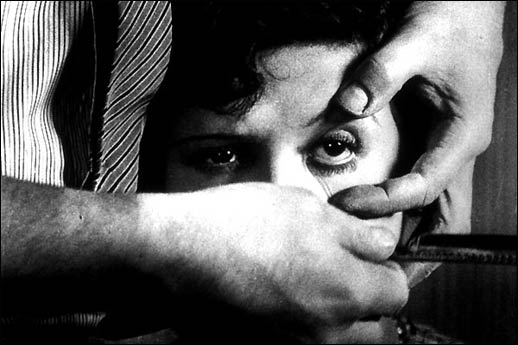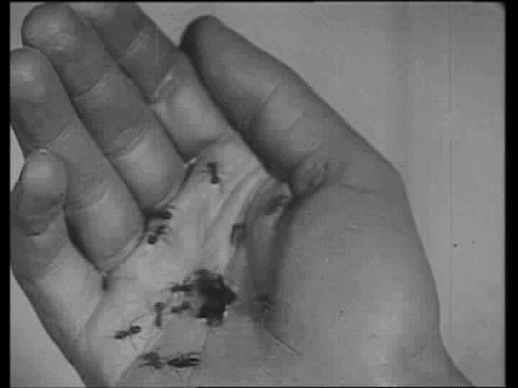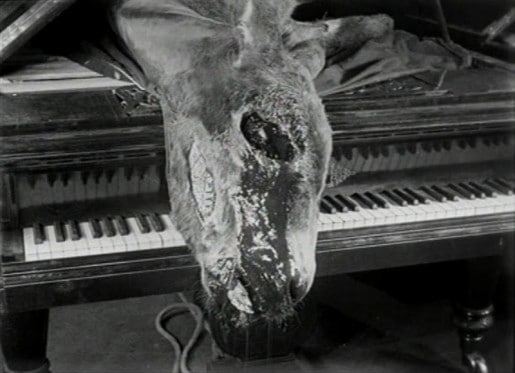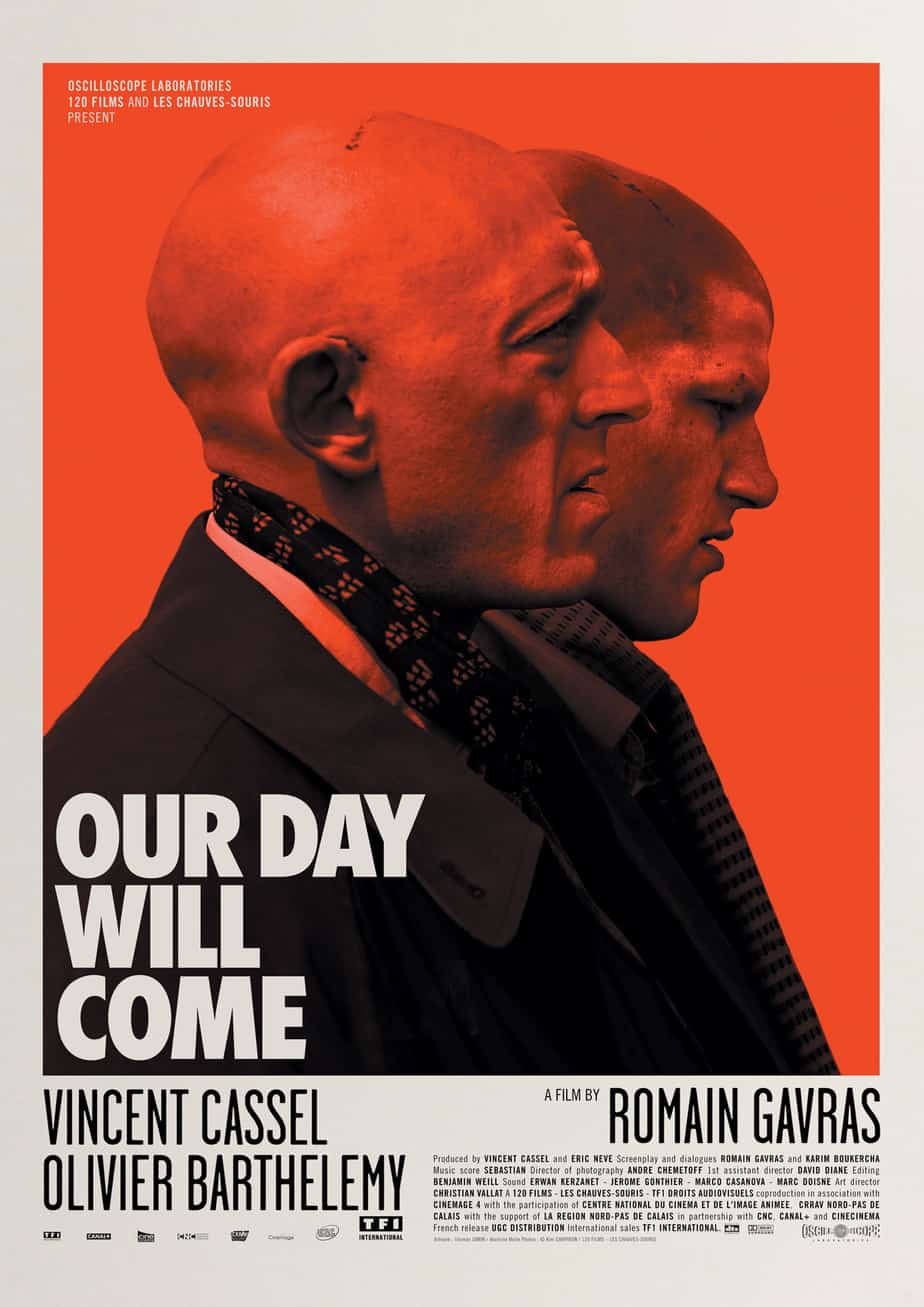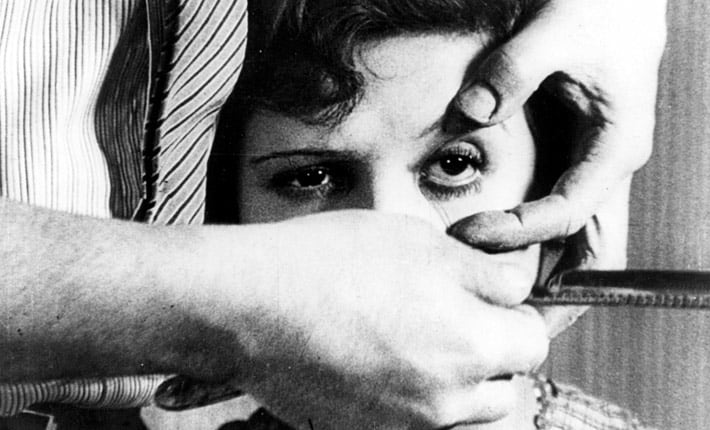
From The Arthouse to The Slaughterhouse: ‘UN CHIEN ANDALOU’
“From The Arthouse to The Slaughterhouse” is a new column that will take a look at the films that have impacted the history of cinema by blurring the line between the beautiful and the grotesque; the thoughtful and the bizarre; the artistic and the horrific. Not content with settling for a straightforward approach to either the arthouse or horror genre, these films defy the standards of “talky” arthouse films and “B movie” shocks and find a way to bridge the gap between the two categories. It’s a look into the films that oppose explanation, interpretation, and reasoning. Yet for some reason, they stick in the minds of both scholars and horror fans alike long after the final reel.
The 1929 silent film, Un Chien Andalou (The Andalusian Dog), is the first film we will be taking a look at. Nothing seems more appropriate to say the least. At a time when Hollywood had their sights set on large-scale dance numbers and musical revues, two Spaniards released a film that no one expected yet alone understood. Does anyone fully understand it to this day? Un Chien Andalou, written and directed by Luis Bunuel and co-written by Salvador Dali, opened the general public to the world of the Surrealism film movement. Surrealism came about as a result of the first World War as many soldiers came back from the war suffering from violent dreams (Post Dramatic Stress Disorder – before it was commonly known as this) and the popularity of psychoanalysis as a tool to cope with the understanding of these dreams. Not only that, but the idea that high society – whose love of fine art and traditional ways of thought – was to blame for the start of the war. The Surrealist movement was not just limited to famous paintings by Max, Dali, and Magritte, but it also included explorations in theater, music, literature, and cinema. Numerous films were released in the 1920’s that were considered Surrealist works. In 1928, Man Ray – a famous surrealist artist – released a short film entitled L’Etoile de mer (The Sea Star). What could be seen as a loose inspiration on Bunuel and Dali, the film follows a couple whose troubled relationship is told through photographing the entire 16-minute short completely out of focus. The film culminates with the woman standing in front of her male companion with a large knife. It can be said that this male and female relationship and the branding of a sharp object was later reversed for the duo’s first film exploration together in 1929: Un Chien Andalou. In 1930, the two would re-team for L’Age d’Or, a film that attempts to illustrate sexual repression by the church through references to the literary 120 Days of Solom and that of the symbol of a scorpion. Unfortunately this film failed to get as much notoriety as their first collaboration and is mostly known as the film that marked the collapse of the two’s friendship.
Much has written about Salvador Dali. His name and iconic mustache are almost as famous as his paintings of melting clocks and elephants on stilts. Un Chien Andalou’s director, Luis Bunuel, is slightly more of an enigma. He got his start helping out on the films of experimentalist filmmaker Jean Epstein. Much later in his career he will become known for his scathing critiques of the bourgeois and high society. He told his friend Salvador Dali at the time that he was having dreams about a cloud slicing the moon like a razor slicing an eyeball. This simple description became the premise for what is considered to be one of the most unforgettable and violent images in cinema history. A straight blade is dragged across a woman’s eye causing it to ooze forth from the slit. Later revealed to be a baby calf’s eye, the striking scene takes place within the first minutes of the film and seems to shake the shackles off of what was surely considered to be traditional cinema at the time. Keeping in mind that the film was made in 1929 gives the scene today even more of an impact in hindsight. It’s a disgusting shot that could shock even the most die-hard gore fans. Needless to say, audiences at the time were shocked as well.
Now this is just the first few minutes. In the 16 –minute short film we are treated to a severed hand, ants crawling out of a man’s palm, and two bloody donkey carcasses. Many have said that the images in the film constitute to nothing more than a random nightmare of sorts that is more interested in shock than logic. But upon closer examination, a careful and symbolic narrative is revealed that explores man’s dark and suppressed desires.
The film begins with a man preparing to enjoy a late night shave. He makes his way to the window and notices the full moon dissected by a thin cloud as he sharpens his blade on a barber’s belt. It is here where the film suddenly cuts to the iconic scene in question. After the gooey sequence, we flash forward to “Eight years later” and see a young man (Pierre Batcheff) dressed in a nun’s habit riding a bicycle down the street. The woman (Simone Mareuil) from the intro scene is now seen watching the man ride down the street before crashing his bike. She brings him up to her place where he proceeds to show her his hand revealing a hole with ants crawling forth from it. Soon after, the two watch a strange woman in the street poking at a severed hand on the ground to the amusement of a staring crowd. The woman in the street than appears to kill herself by standing in front of a moving car. This sight seems to “turn on” the man who begins to grope at the breasts of the woman in the apartment. She attempts to elude the man and is forced into a corner. In a startling series of images, we now see the man restrained from reaching the woman by suddenly revealing two large pianos tied to his back. Not content with that bizarre image, Bunuel and Dali take it one step further by having a bloody donkey corpse laying over each of the pianos. The duo then interchanges shots of the man pulling the pianos and shots of him pulling two clergymen tied to the ends of the ropes. After this segment, a title card of “16 months before” reveals two selves of the same man – one good and one evil – as they seem to fight to be with the woman. The bad self shoots the good self, causing his body to relocate and fall dead in the woods. She is then left with the bad self who is seen literally wiping his mouth off his face. Another time lapse takes place and we see that she has abandoned the evil half of the man and has found a new nice gentleman to be with. You think it is all a happy ending for the two as they walk along the beach until the closing shot shows the happy couple buried in the sand, up to their elbows, unable to move.
It may seem hard to make sense of some of these images after an initial watch, but upon multiple viewings a dark theme seems to emerge. Broken narratives that leap backward and forward in time always seem to create a mild sense of confusion and disorientation. Yet, if you can ignore the leaps in time, at the heart of Un Chien Andalou lies the story of a man attempting to repress his inner dark desires. This is most evident in the scene following the death of the wandering woman in the street. After watching her die, the man seems to become aroused and begins to lunge out and grope at the woman who just took him in. What makes this scene even creepier is how his face suddenly becomes more pale and his eyes become just pools of whiteness. For horror fans it’s not a stretch to say that he resembles a thoughtless zombie. Well . . . not completely thoughtless. The camera now takes on the role of showing us what is going on inside the mind of the zombified man. We now see the woman’s breasts being groped as they are in her character’s dress, then fully unclothed, and then finally wearing an apron. It’s as if he is fantasizing about multiple women while he’s molesting her. These thoughts of sexual fantasies seem to take on a more violent and aggressive approach causing the woman to exert all her energy and hide towards the corner of the room. His conscience seems to have taken the form of interchanging images of him dragging a pair of clergymen and two heavy pianos adorned by bloody animals. These drastically different images seem to represent the two sides of his inner self – the good, ethical self and the evil, violent self – that are later forced to fight one another for the heart of the woman. Whether it is pure and caring or aggressive and obsessive, the love that the man has for the woman is inside of him. So it seems that Bunuel and Dali are making the point that maybe violence is born out of love or vice versa.
It is because of poetic moments like the one mentioned above that make Un Chien Andalou more than just a bizarre excursion into Surrealism. Between the images of the man in the nun’s outfit, to the instance where he becomes scared at the sight of ants crawling from his hand, to finally him lunging towards the woman in the corner, a picture is painted of a man dealing with his own insecurities of being a man. He wants to be the dominant and confident one around the woman even though he is first seen emasculated in a nun’s outfit riding a bike instead of driving a car; this is followed by him crashing his bike and humiliating himself in front of her window. Once he meets the woman, his desire to be dominating (whether by groping or holding her down with his hands) is obstructed by the reveal of a hole in his hand. It’s not certain if this is supposed to represent the resurected Christ showing his wounds to Mary, his mother, after he rises from being crucified. The Freudian implications of these images makes perfect sense given the time period and the Surrealist movement’s general interest in psychoanalysis and dreams. Though you could argue for days about what many of these images symbolizes and how they fit into a cohesive narrative, one doesn’t have to be a doctor to notice the violent and sexual undertones at play here.
Un Chien Andalou is an enigma to both film buffs who have studied the film for years or to the casual viewer who is looking to witness some of the very first gore scenes recorded in film history. It’s a film that still holds the power to shock and disturb without a single line of dialogue or note from tense music; the film has in its place a more jovial traditional French score. Andalou acts as an assault on the viewer as if we too are having our eye forced open to watch this like the girl from the intro. Much like the films that we will be talking about in this new column, Bunuel and Dali’s film analyzes in an artistic fashion, disturbing and strange subject matter that quite often delves into violent and shocking imagery. “From The Arthouse to The Slaughterhouse” is a discussion of the films that intend to disrupt people’s expectations of what is accepted in typical arthouse and horror films. What a great way to start than with one of the very first films to do as such.
Un Chien Andalou can currently be found on Netflix Instant or on DVD through Amazon.

